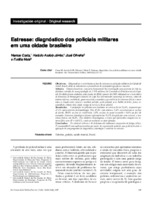Mostrar el registro sencillo del ítem
Estresse: diagnóstico dos policiais militares em uma cidade brasileira
| dc.contributor.author | Costa, Marcos | es_ES |
| dc.contributor.author | Accioly Júnior, Horácio | es_ES |
| dc.contributor.author | Oliveira, José | es_ES |
| dc.contributor.author | Maia, Eulália | es_ES |
| dc.date.accessioned | 2015 | |
| dc.date.available | 2015 | |
| dc.date.issued | 2007 | es_ES |
| dc.identifier.citation | Costa, Marcos,Accioly Júnior, Horácio,Oliveira, José,Maia, Eulália (2007) Estresse: diagnóstico dos policiais militares em uma cidade brasileira. Rev Panam Salud Publica;21(4) 217-222,abr. 2007. Retrieved from http://www.scielosp.org/scielo.php?script=sci_arttext&pid=S1020-49892007000300004&lng=pt&nrm=iso&tlng=pt | pt_BR |
| dc.identifier.uri | http://www.scielosp.org/scielo.php?script=sci_arttext&pid=S1020-49892007000300004&lng=pt&nrm=iso&tlng=pt | es_ES |
| dc.identifier.uri | https://iris.paho.org/handle/10665.2/7876 | |
| dc.format.extent | tab | es_ES |
| dc.relation.ispartofseries | Rev Panam Salud Publica;21(4),abr. 2007 | es_ES |
| dc.subject | Militares | es_ES |
| dc.subject | Doenças Profissionais | pt_BR |
| dc.subject | Polícia | es_ES |
| dc.subject | Estresse Psicológico | es_ES |
| dc.subject | Brasil | pt_BR |
| dc.subject | Estudos Transversais | pt_BR |
| dc.subject | População Urbana | pt_BR |
| dc.title | Estresse: diagnóstico dos policiais militares em uma cidade brasileira | pt_BR |
| dc.title.alternative | Stress: diagnosis of military police personnel in a Brazilian city | es_ES |
| dc.type | Journal articles | en_US |
| dc.rights.holder | Pan American Health Organization | en_US |
| dc.description.notes | OBJETIVOS: Diagnosticar a ocorrência e a fase de estresse em policiais militares da Cidade de Natal, Brasil, além de determinar a prevalência de sintomatologia física e mental. MÉTODO: Estudo descritivo, com corte transversal. Foi investigada uma amostra de 264 indivíduos extraída de uma população de 3 193 militares do Comando de Policiamento da Capital. Os dados foram coletados entre junho de 2004 e janeiro de 2005 utilizando-se o Inventário de Sintomas de Stress para Adultos de Lipp. Foi determinada a presença de estresse, a fase de estresse (alerta, resistência, quase-exaustão, exaustão), a prevalência de sintomas físicos e mentais e a relação entre estresse e unidade policial, posto policial, sexo, hábito de beber, fumo, escolaridade, estado civil, idade, tempo de serviço e faixa salarial. RESULTADOS: A proporção de policiais sem sintomas de estresse foi de 52,6 por cento, enquanto que 47,4 por cento apresentaram sintomatologia. Dos 47,4 por cento com estresse, 3,4 por cento encontravam-se na fase de alerta, 39,8 por cento na fase de resistência, 3,8 por cento na fase de quase-exaustão e 0,4 por cento na fase de exaustão. Sintomas psicológicos foram registrados em 76,0 por cento dos policiais com estresse, e sintomas físicos, em 24,0 por cento. Das variáveis investigadas, a única que apresentou relação com estresse foi o sexo (P = 0,0337), sendo as mulheres as mais afetadas. CONCLUSÃO: Os níveis de estresse e de sintomas não indicaram um quadro de fadiga crítico. É recomendável uma ação preventiva por parte da organização policial, que poderia incluir a aplicação de um programa de diagnóstico, orientação e controle do estresse.(AU) | pt_BR |
| dc.description.notes | OBJECTIVES: To diagnose the occurrence and stage of stress among military police enlisted personnel and officers in the city of Natal (the capital of the state of Rio Grande do Norte, Brazil), and to determine the prevalence of physical and mental symptoms. METHOD: This cross-sectional descriptive study investigated a sample of 264 individuals from a population of 3 193 military personnel from the Natal police command. The data were collected between June 2004 and January 2005 using Lipp's Adult Stress Symptoms Inventory (Inventário de Sintomas de Stress para Adultos de Lipp). The research assessed: (1) presence of stress, (2) the stage of stress (alert, resistance, near-burnout, and burnout), (3) the prevalence of physical and mental symptoms, and (4) the relationship between stress and police unit, rank, gender, drinking, smoking, educational level, marital status, age, years of police service, and salary. RESULTS: No stress symptoms were found in 52.6 percent of the sample; 47.4 percent had symptoms. Of the 47.4 percent of the police personnel with stress symptoms, they were distributed as: 3.4 percent in the alert stage, 39.8 percent in the resistance stage, 3.8 percent in the near-burnout stage, and 0.4 percent in the burnout stage. Psychological symptoms were recorded in 76.0 percent of the police personnel with stress, and physical symptoms in 24.0 percent of them. Of the variables investigated, only gender was related to stress (P = 0.0337), with the female police personnel being more likely to suffer from stress. CONCLUSIONS: The levels of stress and symptoms do not indicate a critical situation of fatigue. However, it is recommended that the police take preventive actions, including implementing an effective program for the diagnosis of, training on, and control of stress.(AU) | pt_BR |
Ficheros en el ítem
Este ítem aparece en la(s) siguiente(s) colección(ones)
-
Pan American Journal of Public Health
Revista Panamericana de Salud Pública

